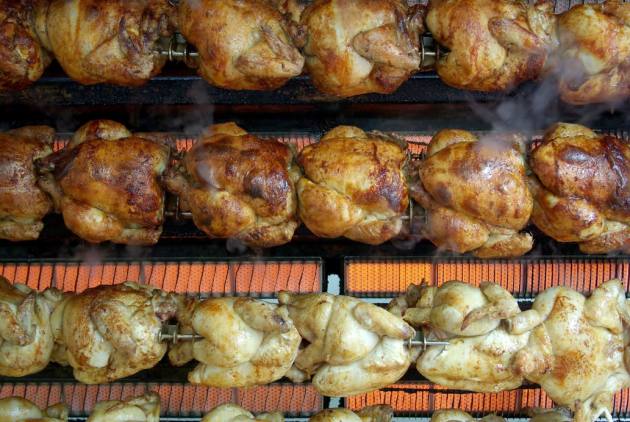Eater.com reports that, while extremely inexpensive, rotisserie chickens you find at Costco and Walmart are priced to rake in billions in other sales at their stores.
It’s hard to believe, but before 1994, grocery stores did not sell packaged rotisserie chickens. Boston Market is credited with convincing consumers to pay for one of the easiest meals to make at home, in the early 1990s, and that’s when grocery stores saw an opening, according to a new Wall Street Journal report. Last year, Americans bought 625 million rotisserie chickens at supermarkets; Costco alone sold 87 million, according to the Journal, 36 million more than they did in 2010.
Today, practically every major publication, from Bon Appetit to Buzzfeed, has published a list of ways to most efficiently transform a grocery store-roasted chicken into several meals. The pre-roasted birds, packaged in plastic or paper and sitting beneath heat lamps at national chains like Kroger and Costco, might be flavored with garlic and lemon or barbecue spices. In addition to the convenience, the smell is a draw, as the Journal points out. It’s enough to get people into the store in the first place, at which point they’ll likely buy other items, making them a loss leader, in industry parlance.
“If they get a chicken, a salad, and maybe they pick up a bottle of wine — now we’re really talking,” Don Fitzgerald, vice president of merchandising at Mariano’s, a grocery chain in Chicago told the Journal.
In other words, as Pricenomics and the WSJ note, rotisserie chickens are no longer (only) a way for stores to sell fresh chicken that might otherwise spoil on the shelf. They’re big business at a time when supermarkets are struggling to attract clientele, and resorting to more creative waysof doing business.
Costco famously keeps its rotisserie chicken in the back of its massive stores, betting that shoppers will pick up additional, perhaps higher-margin items, on their way in and out. That Whole Foods slashed the price of its organic roasted chickens as soon as it was acquired by Amazon — alongside items like avocados and kale — demonstrates their place as an attraction and not just a commodity.
That’s why, though the cost of chicken has risen over the years, it’s advantageous for stores to keep the price of rotisserie chickens down. In fact, rotisserie chicken has long been priced lower than fresh whole chicken, a detail consumers perennially find confusing, and publications taketurns investigating every few years.
Grocery store executives want to keep the purchase price between $5 and $7 per chicken, and are doing this by “working to trim supply-chain costs, cook chickens more efficiently, and throw fewer of them away unsold,” the Journal reports.
Costco, which has priced its rotisserie chickens at $4.99 since 2009, also sells the largest birds on average. (They’re not organic, but they weigh around three pounds fully cooked, which is nearly twice as much as the birds sold at Kroger and Whole Foods.) The big-box warehouse chain is so far ahead in the rotisserie chicken business that it’s building a $300 million chicken-processing plant in Nebraska to service stores across the country.
Costco’s investment is sure to pay off. In just about two decades, grocery stores convinced American cooks to depend on a convenience that was once viewed as a simple, quotidian home-cooked meal.
• Rotisserie Chickens: The ’90s Gift to Supermarkets That Keeps on Giving [WSJ]








